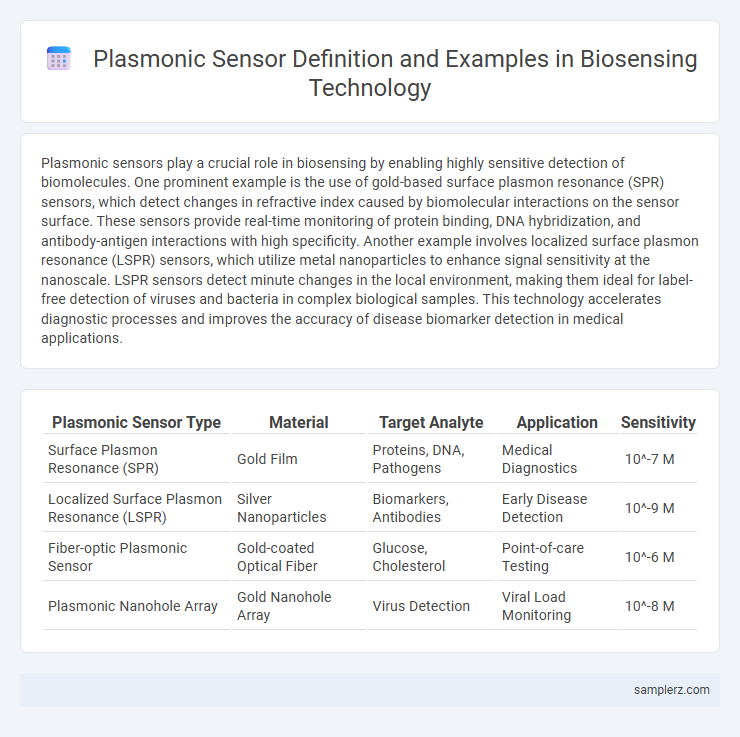Plasmonic sensors play a crucial role in biosensing by enabling highly sensitive detection of biomolecules. One prominent example is the use of gold-based surface plasmon resonance (SPR) sensors, which detect changes in refractive index caused by biomolecular interactions on the sensor surface. These sensors provide real-time monitoring of protein binding, DNA hybridization, and antibody-antigen interactions with high specificity. Another example involves localized surface plasmon resonance (LSPR) sensors, which utilize metal nanoparticles to enhance signal sensitivity at the nanoscale. LSPR sensors detect minute changes in the local environment, making them ideal for label-free detection of viruses and bacteria in complex biological samples. This technology accelerates diagnostic processes and improves the accuracy of disease biomarker detection in medical applications.
Table of Comparison
| Plasmonic Sensor Type | Material | Target Analyte | Application | Sensitivity |
|---|---|---|---|---|
| Surface Plasmon Resonance (SPR) | Gold Film | Proteins, DNA, Pathogens | Medical Diagnostics | 10^-7 M |
| Localized Surface Plasmon Resonance (LSPR) | Silver Nanoparticles | Biomarkers, Antibodies | Early Disease Detection | 10^-9 M |
| Fiber-optic Plasmonic Sensor | Gold-coated Optical Fiber | Glucose, Cholesterol | Point-of-care Testing | 10^-6 M |
| Plasmonic Nanohole Array | Gold Nanohole Array | Virus Detection | Viral Load Monitoring | 10^-8 M |
Overview of Plasmonic Sensors in Biosensing
Plasmonic sensors utilize surface plasmon resonance (SPR) to detect biomolecular interactions with high sensitivity and specificity, making them essential tools in biosensing applications. These sensors leverage metal nanostructures, such as gold or silver nanoparticles, to enhance electromagnetic fields and enable real-time, label-free detection of biomolecules, including proteins, DNA, and pathogens. Advances in plasmonic sensor design have significantly improved detection limits and multiplexing capabilities, facilitating early disease diagnosis and monitoring of biological processes.
Surface Plasmon Resonance (SPR) Sensors in Medical Diagnostics
Surface Plasmon Resonance (SPR) sensors offer highly sensitive detection of biomolecular interactions, making them essential in medical diagnostics for real-time, label-free analysis of proteins, antibodies, and DNA. SPR technology enables early disease detection by quantifying biomarkers at ultra-low concentrations, enhancing the precision of conditions such as cancer, cardiovascular diseases, and infectious diseases. Integration of SPR sensors in point-of-care devices accelerates diagnostic processes and supports personalized medicine through rapid biomarker profiling.
Localized Surface Plasmon Resonance (LSPR) for Pathogen Detection
Localized Surface Plasmon Resonance (LSPR) sensors are widely utilized in biosensing for pathogen detection due to their high sensitivity to refractive index changes near the sensor surface. Gold nanoparticles functionalized with specific antibodies enable selective binding of bacterial or viral pathogens, generating measurable LSPR spectral shifts. This label-free technique allows real-time monitoring of pathogens such as E. coli and influenza virus with rapid response times and enhanced detection limits.
Plasmonic Nanostructures for DNA Biosensing
Plasmonic nanostructures, such as gold and silver nanoparticles, exhibit localized surface plasmon resonance (LSPR) that enhances sensitivity in DNA biosensing applications. These nanostructures enable label-free detection of DNA hybridization by monitoring shifts in resonance wavelength, providing rapid and highly specific identification of target sequences. Integration of plasmonic sensors with microfluidic systems allows real-time, multiplexed DNA analysis crucial for medical diagnostics and genetic research.
Gold Nanoparticle-Based Plasmonic Biosensors
Gold nanoparticle-based plasmonic biosensors enhance biosensing accuracy by exploiting localized surface plasmon resonance (LSPR) for detecting biomolecular interactions at ultra-low concentrations. These sensors leverage the unique optical properties of gold nanoparticles, enabling real-time, label-free detection of proteins, DNA, and pathogens with high sensitivity and specificity. Integration of gold nanoparticle plasmonic biosensors in clinical diagnostics accelerates early disease detection and personalized medicine development.
Plasmonic Sensors for Protein Biomarker Analysis
Plasmonic sensors, such as localized surface plasmon resonance (LSPR) sensors, are highly effective for protein biomarker analysis due to their sensitivity to refractive index changes near the sensor surface. Gold nanoparticles functionalized with specific antibodies enable rapid and label-free detection of low-concentration protein biomarkers, enhancing early disease diagnosis. These sensors offer real-time monitoring capabilities and improved selectivity, making them essential tools in clinical biosensing applications.
Label-Free Plasmonic Sensing in Environmental Monitoring
Label-free plasmonic sensors, such as those utilizing localized surface plasmon resonance (LSPR) on gold nanoparticles, enable real-time detection of environmental pollutants without the need for chemical labels. These sensors offer high sensitivity and specificity for monitoring contaminants like heavy metals and pesticides in water sources. Integrating plasmonic sensing platforms with portable devices enhances on-site environmental analysis and supports rapid decision-making.
Real-Time Plasmonic Detection of Viral Infections
Real-time plasmonic detection of viral infections utilizes surface plasmon resonance (SPR) sensors to monitor biomolecular interactions with high sensitivity and specificity. These plasmonic sensors enable rapid identification of viral antigens or antibodies, facilitating early diagnosis and timely intervention. Integration of nanostructured gold films and graphene enhances signal amplification, improving detection limits to femtomolar concentrations.
Multiplexed Plasmonic Biosensors for Simultaneous Biomolecule Detection
Multiplexed plasmonic biosensors enable simultaneous detection of multiple biomolecules by utilizing localized surface plasmon resonance (LSPR) signals from distinct nanostructures, enhancing sensitivity and specificity in biosensing applications. These sensors employ arrays of functionalized nanoparticles or nanohole arrays to capture different target analytes, facilitating rapid diagnostics and real-time monitoring of complex biological samples. Advances in multiplexed plasmonic biosensor design improve disease biomarker profiling and point-of-care testing through label-free, high-throughput analysis.
Future Trends in Plasmonic Biosensor Development
Emerging plasmonic biosensors leverage nanostructured materials like gold and silver to achieve unprecedented sensitivity in detecting biomolecules at ultra-low concentrations. Integration with advanced machine learning algorithms enhances real-time data analysis and signal processing, enabling point-of-care diagnostics with rapid response times. Future trends emphasize miniaturization, multiplexed detection, and compatibility with wearable devices for continuous health monitoring and personalized medicine applications.

example of plasmonic sensor in biosensing Infographic
 samplerz.com
samplerz.com